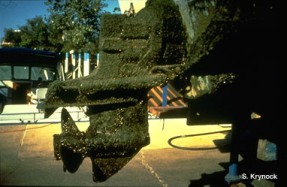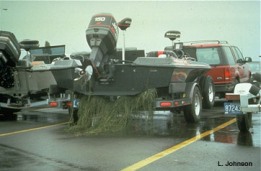|
|
|
| •
|
Invasive Spread
The spread of invasives is occurring by all accounts due to the transportation of aquatics on boat trailers between bodies of water. This is why there now exist laws in Minnesota and Wisconsin prohibiting the transport of any attached vegetation to boats or trailers on public roads.
Through education, many boaters have become aware of the impact they could have on a lakes ecology through the transportation of invasive species such as Eurasian Milfoil. However there still exist large numbers of boaters who are either indifferent or belligerent about cleaning their boats and trailers prior to launch or after pullout. In one study conducted by the DNR on Lake Minnetonka, 12.7% of boaters leaving (1091 out of 8535) and .7% of boaters entering were carrying attached vegetation on their trailers. In one analysis of this data, 50,000 boaters used public accesses on Lake Minnetonka and up to 532 boats may have come from Zebra Mussel infested waters bypassing inspection hours. Upon close inspection, volunteers often uncovered hidden plants on the boat trailers and other recreational equipment. Information collected at the boat landing indicated 6% of all inspected boats had vegetation attached when approaching the landing, while 23% had vegetation attached as the boat pulled away from the landing. Twenty-three percent of all Wisconsin registered boats equates to over 143,000* boats pulling away from the landings carrying aquatic plants that could potentially infect another water body with Eurasian water-milfoil, zebra mussels or other aquatic invasive species. |
Boat Cleanoff Steps
1) Inspect your boat, trailer, and boating equipment and
remove any plants and animals that are visible before leaving
any waterbody. |

